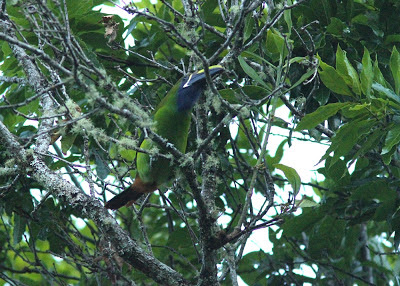Steven tracked down a pair of Emerald Toucanets. One popped out calling immediately over the cabins.
They turned out to have a nest hole nearby. Note the wood chips at the tip of the bill that it's about to release to the winds.
Its mate sat nearby attentatively.
It's always fun to see the bird that's on the cover of the field guide (Garrigues and Dean in this case).
We went another hundred yards or so before Mike found a Black Guan that disappeared into a tree. For a turkey-sized bird it could hide amazingly well. It flew out and teed up eventually though.
We continued to see birds in dribs and drabs. I again thought I saw a tuftedcheek but it was probably just another Spot-crowned Woodcreeper. Rhoda heard a Ruddy Pigeon that we tracked down. Ruddy-capped Nightengale-thrush and more Collared Redstarts bounced about. A group of Sulphur-winged Parakeets flew down into the close edge of an apple orchard. Most of the parakeets that we saw were flyovers ID'd by the guides by call; it was nice to see some perched.
The local race of Red-tailed Hawk flew over while we were watching the parakeets. Apparently it's lumped with a Caribbean subspecies. I don't know if there are clinal intermediates, but the short tail and very broad secondaries are nothing even remotely similar to our birds in shape at least.
A Yellowish Flycatcher was another riff on the Empidonax theme, another fairly ID-able version. The big teardrop about the eye certainly gave it a Cordilleran Fly resemblance.
Mike and I had a good look at a Gray-bellied Wood-wren, one of the dominant songsters of the highlands.
We also had another (much closer than the day's before) look at Flame-throated Warbler (or Parula as I bet it'll be called in the future).
Finally a Brown-capped Vireo, a bird that acted (and sounded) like a Warbling Vireo.











No comments:
Post a Comment